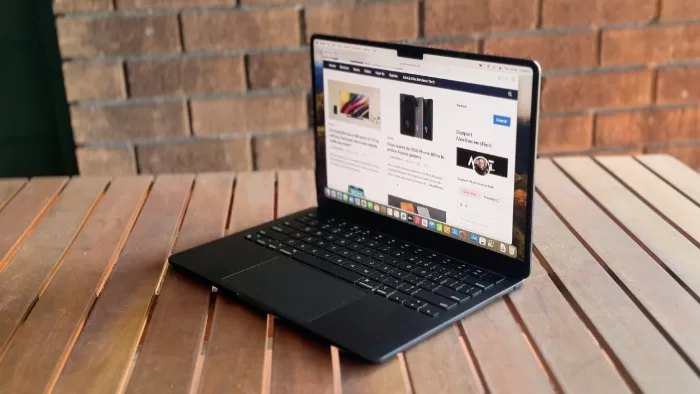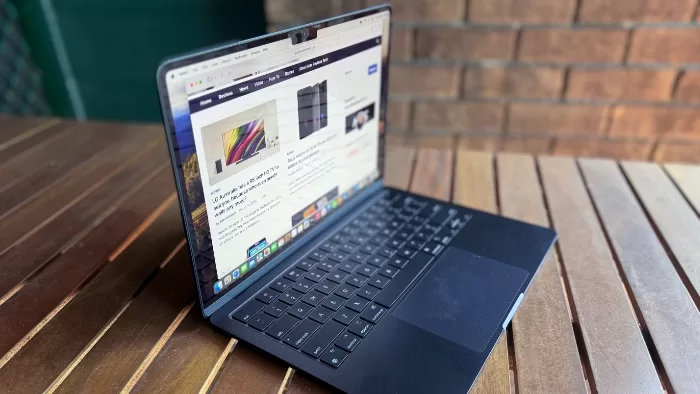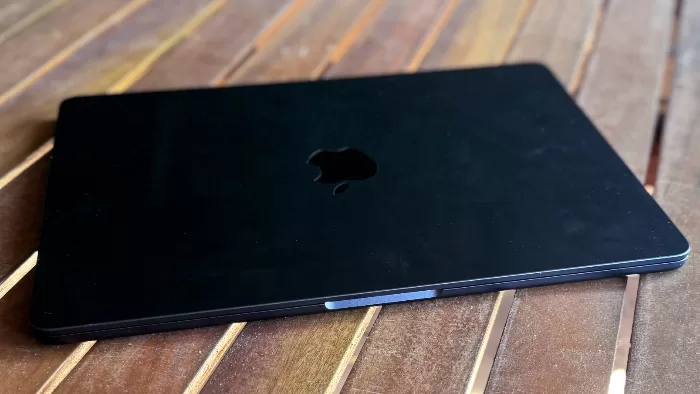
Apple’s updated MacBook Air M3 is an excellent laptop, though it does pose the question around how much power you really need in a laptop.
| Pros | Cons |
|---|---|
| M3 provides a nice speed boost, especially over M1 or older MacBooks | Limited ports compared to MacBook Pro |
| Supports dual monitors | Apple’s reasoning for older Airs not supporting dual monitors is sketchy at best |
| Good battery life given its improved processing power | Apple Silicon can’t be upgraded, so buy what you need now. |
Score: 4/5
 |
Buy The MacBook Air M3! | Buy On Amazon |
Apple’s MacBook Air started life as an absolute luxury executive option – I remember, I was literally in the room when Steve Jobs did his whole “pull it out of an envelope” trick back in the day – but over the years, it’s become Apple’s mainstream option. If you don’t want Pro power (or Pro pricing), the MacBook Air is the Apple laptop for you.
The Apple MacBook Air M3 continues that journey, though with upgraded internals that push the line between Pro and Air models even closer, especially if you compare performance to some Pro models that really aren’t that old at all.
Design

Am I committing some kind of social faux pas by saying that all MacBooks look alike?
Because, damn… they really do. Judge me for that if you must.
Apple sent me the Midnight 13 inch MacBook Air M3 to test out, and it just so happens that my regular day-to-day machine is a Midnight 13 inch MacBook Air M2.
You want to know how I tell them apart? My own personally owned MacBook Air M2 has a Godzilla sticker over the Apple Logo, partly because I’m me, but mostly because my better half also has a Midnight 13 inch MacBook Air M2, and we need some way to tell them apart.

Without that, there would be three visually identical MacBook Air models to mix up around here right now. Same 13 inch screen – though for the M3 you can opt for a 15 inch display if you like to go large – with the same 2560×1164 pixel LED backlit IPS display at 500 nits. Same colour choices in Silver, Starlight, Space Grey or Midnight. It even weighs the same, so while the underlying M3 processor might be more powerful, it’s not doing so with more heft in your bag or hand.
Same array of ports on the left hand side, with dual Thunderbolt 3 and Magsafe 3 charging, while the right hand side houses the headphone jack.
Because it’s the same, I’ll make the same complaint I’ve made for a while now in Apple’s direction.
Cramming most of the ports on the upper left hand side is a waste of space, and an inconvenient one to boot.
If you’ve got larger USB-C plugs to throw into the left side, it can be a bit of a kludge getting them to fit. Throwing one port to the right, which it does with the Pro models would solve for this, as well as allowing charging over USB-C from either orientation. As always, Apple’s answer for that is likely to be that if I want ports on both sides, I should buy a MacBook Pro… which is naturally a more expensive option.
That being said, there’s also the argument here that Apple’s gone down the “if it ain’t broke” road for the Apple MacBook Air M3. The display is nice, the keyboard responsive and the trackpad works well.
Having the choice between 13 and 15 inch models gives flexibility, too. I would opt for the 13 inch model (as is clear from me buying the 13 inch M2), but if you want or need the greater screen real estate, it’s totally feasible for you to do so.
Performance

The MacBook Air M3 runs on the base level M3 Apple Silicon system only, where the Pro models have the option of M3, M3 Pro and M3 Max variants depending on your budget and just how much power you feel you need for your daily computing tasks.
I’ve previously only tested with the M3 Max, so getting to grips with the base level model was something I was looking forward to.
Also read:
Apple MacBook Pro M3 Max Review
Previous testing with Apple Silicon Pro and Air models on the same architecture has generally favoured the idea of getting the Air models and saving a few bucks unless you’re going to run them very hard indeed, where the fan in the Pro models can play its part.
Apple loaned me a 13 inch Apple MacBook Air M3 with 16GB of RAM, an 8-core CPU and 10-Core GPU with a 1TB hard drive. That configuration would run you $2,699 at the time of writing, a fair step above the entry level $1,799 model.
That entry level variant has just 8GB of RAM, an 8-core CPU and 8-Core GPU setup and 256GB of onboard storage.
As always, choose carefully when buying MacBooks, because the integrated nature of Apple Silicon means you can never upgrade RAM or internal storage after configuration.
The M3 should bring with it a speed bump, but how much of a speed bump do you get? It depends where you’re coming from.
At a CPU level, there’s a clear performance curve at play here if we use Geekbench 6 CPU’s benchmark to compare to older and current generation models:
Not surprising that the MacBook Pro models top the chart there, given their price points. The Apple MacBook Air M3 does best out the basic MacBook Pro M2, but it would be a tad silly to suggest upgrading from a laptop that’s only a year old at best.
What’s interesting here is the gulf between the first generation Apple Silicon M1 systems and the Apple MacBook Air M3 – and of course, the even older Intel-based models. Those are the buyers that Apple’s pretty clearly targeting here.
At a GPU level, I’ll turn to Cinebench, first of all using its older Cinebench R23 benchmark, predominantly because I have scores for those older systems to use comparatively:
Again the Apple MacBook Air M3 compares well for its price point, though predictably the heftier and pricier Pro models did outpace it.
Cinebench has since updated its benchmark suite to Cinebench 2024, though I’ve got fewer figures to compare with here:
This 100% gels with my own observations around the Apple MacBook Air M3. Using it for video editing with Final Cut Pro, it’s a tad faster than my day-to-day Air M2 model, certainly workable if I’m not pushing too many other apps or in the field.
Given the choice, I’d do that work on a MacBook Pro with a beefier processor set and a fan that can kick in to activate cooling. Something would be badly wrong if the $7249 Pro model wasn’t the fastest in that particular scenario.
That leaves me with the comparison between the Air M3 and Air M2, and this is where it gets interesting. Apple hasn’t stopped selling the Air M2 entirely, though it has scrubbed the 15 inch model from its books.
While it’s not “cheap”, starting at $1,599, it’s still a nicely powerful machine that clearly outpaces the older Intel-based MacBook Air models while not sitting that far below the M3.
If you’re configuring upwards in terms of storage and RAM, bearing in mind that none of these laptops are upgradeable in any way at all after purchase, then the M3 probably makes more sense given Apple’s general pricing – but at the entry level, if 8GB of RAM can do what you need on a daily basis, the line between the M2 and M3 models isn’t that great.

The one new feature that the Apple MacBook Air M3 can manage that the Apple MacBook Air M2 can’t is native dual monitor support. I’ve tested it, and it certainly works if you’re the multi-monitor type, though it also annoys me.
Why? Because previously Apple’s contention was that multi-monitor was a Pro-only feature, even on the older M2 and M1 architectures. It’s always felt like it sits on the sketchiest of rationales, basically an extra feature that the company wants you to pony up more for the Pro model to get.
The fact that it will run on the Apple MacBook Air M3 does rather point to the fact that it could have done so on the M2 and M1 variants as well – and there are third party solutions that handle that even if Apple doesn’t want to. It feels like an artificially imposed barrier to me, and that irks me. Maybe that’s just me.
Battery

With only a week’s testing, I’ve not been able to push the Apple MacBook Air M3 to its absolute limits in terms of battery testing, but what I’ve seen so far has been both predictable and pleasing.
Apple’s general claim for the 13 inch models is for “up to” 18 hours of Apple TV movie playback or 15 hours of wireless web use. It’s the same figure as for the M2 models, despite the higher processing power, and the Apple MacBook Air M3 certainly tracks the same way as the Apple MacBook Air M2 that I’m very familiar with.
For everyday writing work and web surfing, those figures are generally achievable, but if I’m editing video on the Apple MacBook Air M3, it drops off sharply, and again that’s totally what I’d expect. There’s certainly scope here for a full working day’s battery coverage.
On the charger front, you get a Magsafe-compatible charger in the box; on the entry level M3 it’s just a 30W charger, but for the 10-core models it’s a 35W model with a USB-C socket inbuilt for charging other devices such as iPhones, iPads or, well, the vast majority of modern gadgets. There’s also an option for a 70W straight charger if you need to juice up your Apple MacBook Air M3 rapidly.
You can configure the baseline models with the 35W charger if you wish, at a cost of $30 over the price of the regular charger. That’s also what you’d pay at checkout for the 70W model. If you want either after the fact, they’ll set you back $89 each.
Apple MacBook Air M3: Alex’s Verdict

The MacBook Air M3 is an impressive machine, and a fine choice if you’re in the Apple camp and are upgrading from an older machine, especially if that machine has an Intel processor lurking under the hood. The productivity boosts you would see there would be immense.
That being said, there’s definitely a space here to consider the cheaper Apple MacBook Air M2 as well. If you’re doing lots of heavy pixel pushing and can’t meet the asking price of the Pro M3 models, then the M3 Air is your best bet, but if your needs are more modest, the M2 is a lovely machine – and one that’s now even more affordable.
MacBook Air M3: Pricing and availability
Apple’s pricing for the MacBook Air M3 starts at $1,799. The model loaned to me by Apple used for testing would cost you $2,699.
 |
Buy The MacBook Air M3! | Buy On Amazon |
Was this review useful to you? Support independent media by dropping a dollar or two in the tip jar below!





